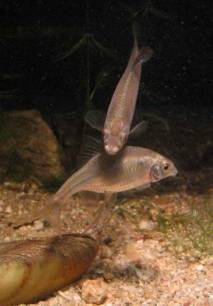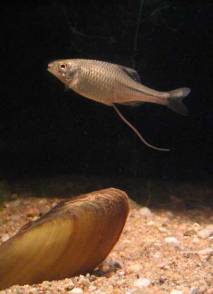
Bitterlings (Rhodeus sericeus amarus).
Source: Martin Reichard.
 Bitterlings (Rhodeus sericeus amarus). Source: Martin Reichard. |
The bitterling (Rhodeus sericeus amarus) is a small carp-like fish, which usually has a quite inconspicuous colour of grey silvery green with an opalising lateral stripe. The necessary water quality prevailing, bitterlings are to be found in slowly flowing lower parts of rivers and in lakes north of the Alps, in Scandinavia and a major part of the British Isles.
The bitterling, though, is not at all as frequent, as it could be, and that is because of its breeding place.
As a breeding place in the appropriate time, the bitterling finds itself a refuge between the two halves of a large painter or pond mussel (Unio or Anodonta).

Female bitterling with oviposition tube. Source: Martin Reichard. |
During breeding time the male bitterling selects itself a suitable mussel, which it defends against other males. The female on the other hand at this time grows a 5 - 6 cm long laying tube behind the anus opening.
If the female, ready to spawn, approaches the male, then this performs a ritualized dance, in order to lure the female to its mussel.
The female lays its eggs in the pallial cavity of the mussel, using a special oviposition tube. Then the male fertilises the spawn by discharging the milk over the mussles inhalent siphon. That way, the sperm cells are carried into the plalial cavity by the stream of the mussel's respiratory water.
In the mussel's pallial cavity the fertilised eggs develop and leave the shell after approximately 3 - 4 weeks as small bitterlings. Since usually several bitterlings use the same mussel successively, one can often find numerous different development stages of juvenile bitterlings in it.
While a bitterling may reach an age of up to five years, by two it reaches maturity. The presence of pond mussels is mandatory for the bitterling's reproduction and population increase.
The problem is only, mussels have become rare. And so the bitterling must, as well as the mussel, be counted among the endangered animal species in our waters.